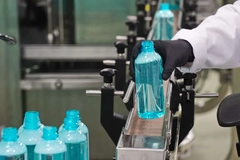New MAP Technology Gives a Longer Shelf Life and Better Clarity

Our nano-pinning technology is similar to that of most European companies’ MAP production processes in that holes are created to modify the package’s atmosphere.
01/07/09 Hanjin P&C has developed a new manufacturing technology for modified atmosphere packaging (MAP) that triples product shelf life at lower costs.
Using a patented nano-pinning technology that involves the use of very small needles to puncture tiny holes in the packaging film, Hanjin has produced a new MAP branded Longfre that allows for better control of the movement of air in and out of the film.
Kang Minkyoung of Hanjin explains, “Our nano-pinning technology is similar to that of most European companies’ MAP production processes in that holes are created to modify the package’s atmosphere.
“However, Europe uses a laser technology which makes bigger holes. With our needle process, we can create much smaller holes which in turn better allows fruits and vegetables to breathe – this maintains and extends the freshness of the packaged product.”
After three years of development, Hanjin launched Longfre at the beginning of 2008 and now provides all the MAP needs of South Korea’s largest bean sprout company, Pulmuone, which has 60% market share.
“Previously, Pulmuone used BOPP film sourced from Japan to package its products. About one and a half years ago, we helped them improve their BOPP packaging with our MAP technology and extended the shelf life of their bean sprout range of products to 12 days with a three micro thickness,” says Kang.
“Other MAP technology would only give bean sprouts a four-day shelf life.”
According to Kang, while MAP technology from Japan provides a similar shelf life as that of Hanjin’s, Longfre packaging has much higher clarity.
“Japanese MAP technology involves the use of tiny diamond particles to scratch and thin out packaging film,” he notes. “While such a process gives packaged products a longer shelf life than that of European MAP technology, it has its own set of problems.
“For example, some of the diamond particles used in the scratching process may be slightly larger than others and end up creating holes instead of just thinning out the film, making it more difficult to control oxygen movement.
“So Japanese MAP can only provide a 50% guarantee, while we can guarantee up to 85% of the packaging’s atmosphere.”
In addition, Kang says that the scratching manufacturing process compromises the clarity of the MAP film.
“Consumers like to be able to have a good look at the product they are purchasing. Longfre’s nano-pinning technique allows for that and creates uniform holes, while Japanese MAP doesn’t.”
With its new MAP technology, Hanjin hopes to help other companies besides Pulmuone, both in Korea and other countries.
“Since we launched Longfre one and a half years ago, we’ve only focused on servicing Pulmuone because we wanted to make sure our new packaging product has a good start,” says Kang.
“We believe now is a good time to promote Longfre, especially in Korea where knowledge and usage of MAP is still small. There is a lot of room for potential.
“Longfre provides longer shelf life for fresh produce, has very good clarity, and is also more affordable than other MAP in the global market. We’ve a very good product and we’re excited to share it with the world.”











